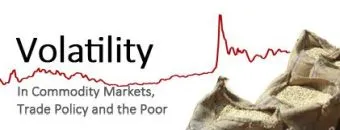Storage and Trade
Trade policies and food reserves are crucial factors for price behavior in domestic and international markets.
Storage largely determines domestic food supply and as a result plays an important role in price formation and stabilization. If stocks are sufficiently high they easily absorb supply and demand shocks. In contrast, a low level of stocks cannot prevent large movements in prices due to shocks.
Commodity imports are another means to stabilize domestic prices in times of domestic food supply deficit. Public stabilization programs such as buffer schemes or strategic reserves can overcome market inefficiencies and can reduce price variability. However, they come at high economic and fiscal costs. The optimal combination of trade and storage policies depends on a government’s risk aversion towards price volatility and their weights for consumer and producer welfare.
In general, it is believed that prices of tradable commodities are largely driven by international prices, trade policies, and transaction costs. Against this background, trade policies of large suppliers or importers which determine global supply and demand transmit to international prices. In consequence, uncoordinated trade policies largely affect international prices and greatly harm import dependent countries.
Appraising whether international price volatility is actually endangering domestic price stability in developing countries is one of the aims of our research. Further, we investigate the impact of trade and storage policies on domestic and international prices.
Publications
- Kozicka, M., M. Kalkuhl & J. Brockhaus (2017). Food Grain Policies in India and their Implications for Stocks and Fiscal Costs: A Dynamic Partial Equilibrium Analysis. Journal of Agricultural Economics, 68(1), pp. 98–122.
Brockhaus, J. (2016). The Role of Storage and Information in Stabilizing Food Prices and Supplies. Ph.D. Thesis. University of Bonn.
Brockhaus, J., J. Huang, J. Hu, M. Kalkuhl, J. von Braun & G. Yang (2016). When Do Prices Matter Most? Rice, Wheat, and Corn Supply Response in China. In M. Kalkuhl, J. von Braun, & M. Torero (Eds.), Food Price Volatility and Its Implications for Food Security and Policy. Springer International Publishing.
Kornher, L. & M. Kalkuhl (2016). The Costs and Benefits of Regional Cooperation on Grain Reserves: The Case of ECOWAS. In M. Kalkuhl, J. von Braun, & M. Torero (Eds.), Food Price Volatility and Its Implications for Food Security and Policy. Springer International Publishing.
Mujahid, I. (2016). Assessing the Role of Trade and Reserve Cooperation in the Food Price Dynamics: Indonesia in the Regional and Global Economic Architecture. Ph.D. Thesis. University of Bonn.
Mujahid, I. & M. Kalkuhl (2016). Do Trade Agreements Increase Food Trade? The World Economy, 39(11), pp. 1812–1833.
Mujahid, I. & L. Kornher (2016). ASEAN Food Reserve and Trade: Review and Prospect. In M. Kalkuhl, J. von Braun, & M. Torero (Eds.), Food Price Volatility and Its Implications for Food Security and Policy. Springer International Publishing.
Saini, S. & M. Kozicka (2014). Evolution and Critique of Buffer Stocking Policy of India. ICRIER Working Paper No. 283. [PDF]
Kornher, L. and M. Kalkuhl (2013) "Food price volatility in developing countries and its determinants" GEWISOLA Conference Paper [PDF]



